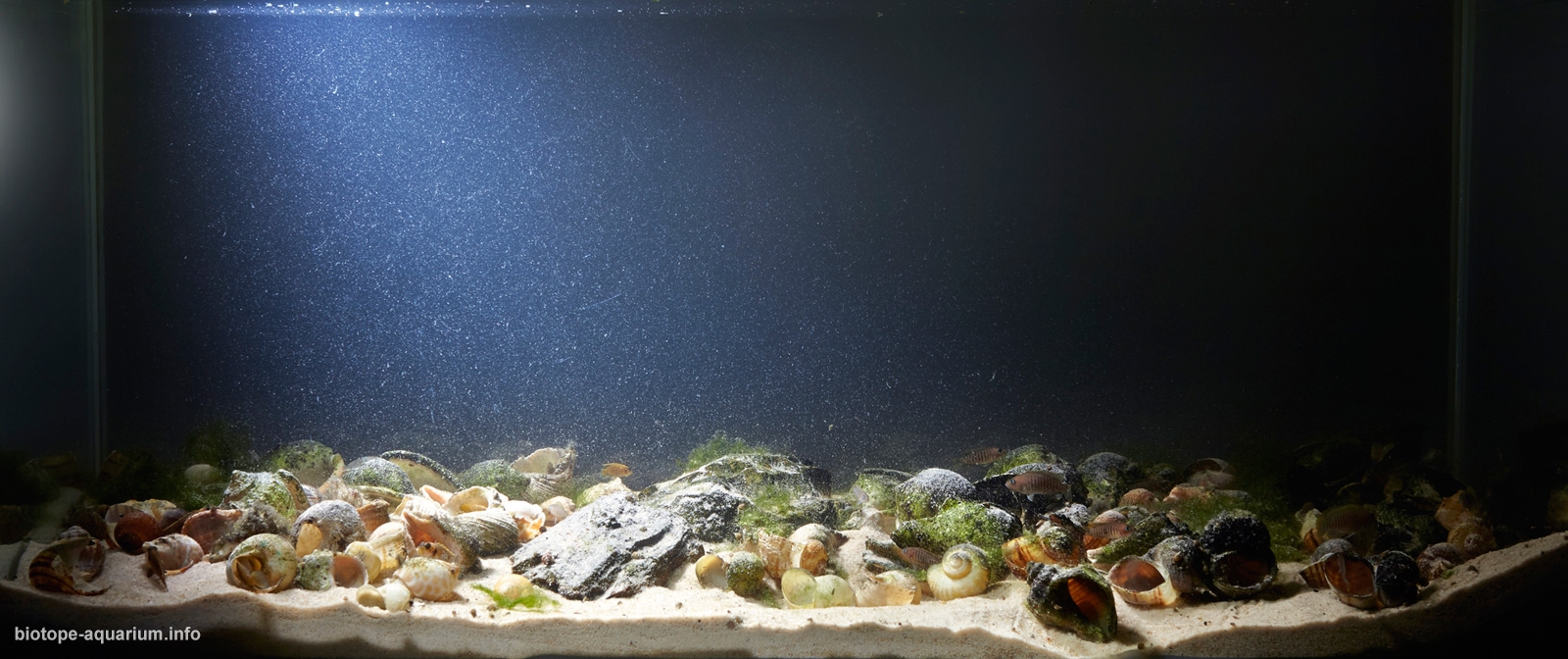Tanganyika Lake, sandy biotope of Isanga Bay, Zambia
31st place in Biotope Aquarium Design Contest 2017
![]() Russia. Matvey Sokolov
Russia. Matvey Sokolov

Volume: 75 L
Dimensions: 35x30x75 cm
List of fishes: Neolamprologus multifasciatus, Lamprologus ocellatus Isanga gold
List of plants: Cladophora
Description of decorations: On the bottom there is fine light sand, shells of gastropods, UDeco Fossilized wood stone.
Description of equipment: Tetra EasyCrystal FilterBox, LED lights AquaLighter 1.
Water parameters: pH 7.2, GH 8, KH 6
Description of the area surrounding the biotope: Coastal landscapes, as a rule, are huge rocks and only on the east side of the coast gently sloping. On the west coast, steep side walls of the East African rift zone, forming the coastline, reach 2000 m height. The coastline is dotted with bays. The largest of them is the Bay of Burton. The lake gets water from several tributaries, the area of the basin is 231 thousand km². The largest river is Ruzizi, its delta is in the northern part of the lake. On the eastern side, the Malagarasi river is of a more ancient origin than Tanganyika, and in the past it flowed directly into the Congo River. The only river flowing out, Lukuga, starts in the middle part of the west coast and flows to the west, connecting with the river Congo, which flows into the Atlantic ocean.
Description of the underwater landscape of the biotope: Visual characteristics of the underwater landscape: In the coastal zone, the underwater landscape of the lake is a heap of rocks and fragments of rocks of different sizes. The more the distance from the shore is, the less stones there are on the bottom, and a few hundred meters from the shore you can see a smooth light sandy bottom, covered with shells of shellfish Neothauma tanganicense. Small species of lamprologs, such as Neolamprologus multifasciatus and Lamprologus ocellatus, live here, and they are present in this aquarium. These small cichlids use shells as shelters for life and spawn. In nature, these species often coexist with each other, but in the aquarium it was decided to use stones to devide the territory of the two species and reduce possible conflicts. However, it turned out that fish are much more likely to conflict within their species, rather than with a neighbor species. The stone was very soon buried in the sand, and some N. multifasciatus migrated to the territory of the neighbors, taking part of their shells. L. ocellatus did not seem to mind, which was also surprising, since this species is generally more aggressive, the fish usually attack violently even an arm dipped into the aquarium, whereas N. multifasciatus in danger instantly hide in the shells. Perhaps the reason was that the colony of N. multifasciatus was several times larger than the colony of L. ocellatus. In general, dwarf shell cichlids are an interesting object for observations in an aquarium.
Description of the parameters of the habitat: The water temperature of Tanganyika is very different in layers. in the upper layer the temperature fluctuates from 24 to 30 degrees, with a decrease at great depths. Because of the different density of water and the absence of bottom currents, the layers do not mix, and the temperature on the lower horizons reaches only 6-8 degrees. The depth of the different temperature layer is about 100 m. The water of Tanganyika is very transparent (up to 30 m). In it a lot of salts are dissolved in small concentrations, so that in its composition it resembles a very dilute sea salt. The water hardness (mainly due to magnesium salts) varies from 8 to 15 degrees. Water has an alkaline reaction, pH 8.0-9.5.
List of fishes: In the lake there is a lot of cichlid species from the genus Julidochromis, Tanganicodus, Telmatochromis, Tropheus, Lamprologus, Spathodus, Cyprichromis, Astatotilapia, Limnotilapia, Ophtalmotilapia etc.
List of plants: The species diversity of higher aquatic plants in the lake is small, and their greatest density is observed in the mouths of rivers flowing into the lake. There are representatives of the family Potamogeton and the genera Vallisneria, Ceratophyllum. Algae are rapidly developing in the zone of stones. At a depth exceeding 200 m, the water is saturated with hydrogen sulphide, that is why it is unsuitable for the development of vegetation.
Threats to the ecology: The ecological situation around the lake from year to year is becoming more strained, especially in its northern part, near the coast of Burundi. The water of the Tanganyika lake constantly gets industrial, agricultural and domestic waste. Due to the lack of running water and sanitation, residents of coastal villages often do natural needs directly into the lake, while they take water for domestic needs from the same water body. Another problem threatening the ecosystem of Tanganyika is new plant species. Of these, the greatest danger, according to scientists, has water hyacinth (Eichhornia crassipes). Growing at high speed, this plant covers the surface of the lake with dense carpet, which prevents access to sunlight, and also disrupts the natural oxygen regime of the reservoir. This leads to the migration or death of organisms living in the lake.
Sources of information: http://topkin.ru/best/priroda/tanganika-samoe-glubokoe-ozero-afriki/; http://www.tanganyika-collection.ru/index.php?id=106&mod=2; http://catfishes.ru/tanganika-raj-dlya-cixlid/; https://ru.wikipedia.org/wiki/Танганьика; https://geographyofrussia.com/tanganika/; http://arshba.ru/ozero-tanganika-opisanie-parametri-v..; aqfi.ru/art/123-ozero-tanganika.html; http://all4aquarium.ru/ru/events/jbl-biotope-contest-..; aquafisher.org.ua; http://www.aquaforum.ua/showthread.php?t=172266; https://vk.com/im?sel=6896431&z=video6896431_456239019%2F551b1471731b69c068; https://vk.com/im?sel=6896431&z=video6896431_456239020%2F3b951c2e9753debcfa; https://vk.com/im?sel=6896431&z=video-52983980_171045298%2F33fb6b4ae652c09092; http://www.tanganyika.ru/bio.php; http://www.aquariumhome.narod.ru/stat30.htm?utm_source=aqa_ru&utm_medium=forum&utm_campaign=redirect
